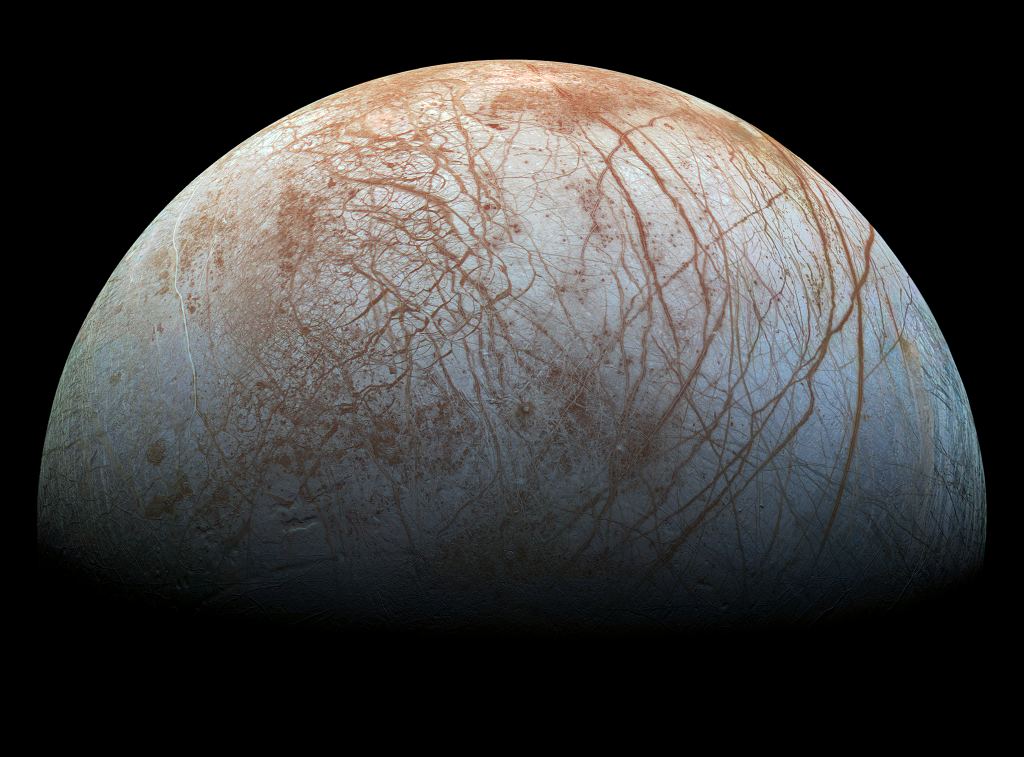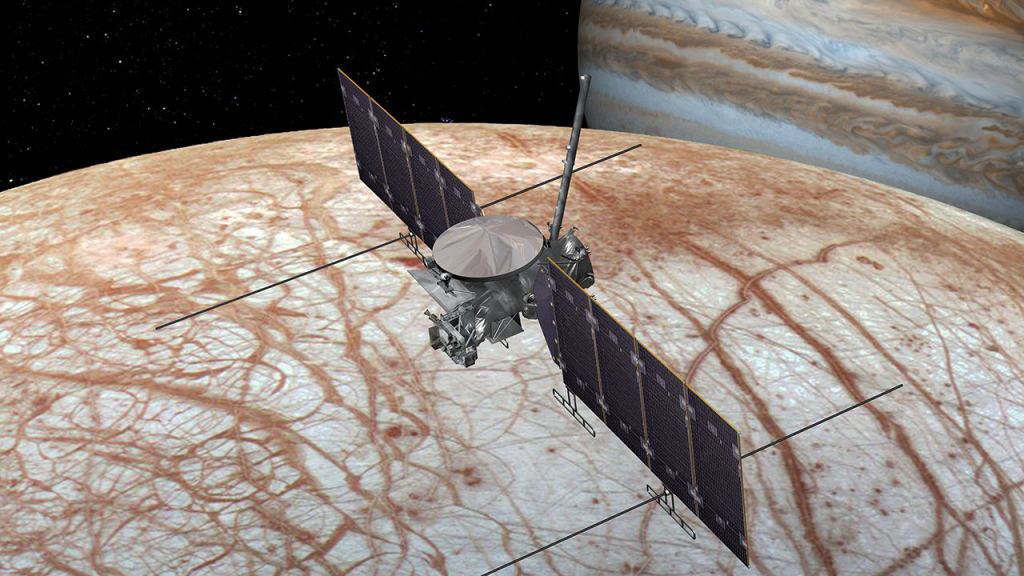This next week will mark a scientifically valuable achievement for NASA’s Juno mission, as the pioneering spacecraft is slated to fly within 358 kilometers (222 miles) of Jupiter’s icy moon Europa on September 29 at 5:36 a.m. EDT (2:36 a.m. PDT) as part of its extended mission to explore the Jupiter system. A flyby this close to Europa’s surface will allow Juno to acquire some of the highest-resolution images ever taken of the icy moon. For context, the last mission to explore Europa in depth was NASA’s Galileo spacecraft, which got within 351 kilometers (218 miles) of the surface on January 3, 2000.
 False color mosaic of Europa taken by the Galileo spacecraft during its first and fourteenth orbits in the Jupiter system, in 1995 and 1998, respectively. (Credit: NASA/JPL-Caltech/SETI Institute)
False color mosaic of Europa taken by the Galileo spacecraft during its first and fourteenth orbits in the Jupiter system, in 1995 and 1998, respectively. (Credit: NASA/JPL-Caltech/SETI Institute)
High-resolution images aren’t the only objective, as Juno is expected to gather data regarding Europa’s ionosphere, interior, surface composition, and the moon’s interaction with Jupiter’s magnetosphere. All this new data about Europa could be useful for future missions, to include NASA’s Europa Clipper, which is currently scheduled to launch in October 2024 and arrive at Jupiter in April 2030.
“Europa is such an intriguing Jovian moon, it is the focus of its own future NASA mission,” said Dr. Scott Bolton of the Southwest Research Institute in San Antonio, and the Principal Investigator of the Juno mission. “We’re happy to provide data that may help the Europa Clipper team with mission planning, as well as provide new scientific insights into this icy world.”
Along with gathering valuable scientific data during the close flyby, Juno’s trajectory will also be modified, decreasing the number of days the spacecraft takes to orbit Jupiter from 43 to 38. This flyby will also make Europa the second Galilean satellite to be explored by Juno during its extended mission, with the first being Ganymede in June 2021, and is also slated to make close flybys of Io in 2023 and 2024.
While the most valuable images and data will undoubtedly occur at closest approach, Juno will start collecting data about an hour earlier when the spacecraft is within 83,397 kilometers (51,820 miles) of the icy moon.
“The relative velocity between spacecraft and moon will be 14.7 miles per second (23.6 kilometers per second), so we are screaming by pretty fast,” said Dr. John Bordi, Juno deputy mission manager at NASA’s Jet Propulsion Laboratory in Pasadena. “All steps have to go like clockwork to successfully acquire our planned data, because soon after the flyby is complete, the spacecraft needs to be reoriented for our upcoming close approach of Jupiter, which happens only 7 ½ hours later.”
Juno carries a myriad of scientific instruments that have been utilized while exploring Jupiter, and they will all be active during this close flyby of Europa to collect as much data as possible about the icy world. This includes the Waves, Jovian Auroral Distributions Experiment (JADE) and Magnetometer (MAG) instruments searching for possible water plumes above Europa’s surface.
“We have the right equipment to do the job, but to capture a plume will require a lot of luck,” said Dr. Bolton. “We have to be at the right place at just the right time, but if we are so fortunate, it’s a home run for sure.”
Juno’s Microwave Radiometer (MWR) instrument will acquire data on the composition and temperature of Europa’s water-ice crust, which marks the first time such data on Europa’s icy shell has been collected.
To top it off, Juno’s JunoCam will attempt to take four visible-light images of Europa during the close flyby with an expected resolution of 1 kilometer (0.6 miles) per pixel. Once received back on Earth, the Juno science team will contrast them with images from past missions, searching for differences in Europa’s surface features that might have transpired within the last two decades. As stated, all this new data will assist the upcoming Europa Clipper mission, as that spacecraft is slated to make 50 flybys of Europa when it arrives at Jupiter in April 2030. Therefore, this close flyby of Europa by Juno can be thought of as a test run for Clipper.
 Artist’s rendition of Europa Clipper above Jupiter’s moon Europa. (Credit: NASA/JPL-Caltech)
Artist’s rendition of Europa Clipper above Jupiter’s moon Europa. (Credit: NASA/JPL-Caltech)
What new findings will Juno teach us about this Europa’s icy shell and the moon overall? We’ll know soon enough, and this is why we science!
As always, keep doing science & keep looking up!
Featured Image: Jupiter’s moon Europa taken by the Juno spacecraft’s JunoCam on October 16, 2021, from approximately 82,000 kilometers (51,000 miles). (Credit: NASA/JPL-Caltech/Southwest Research Institute/Malin Space Science Systems)

